The History Of Toyota 4runner

The Toyota 4Runner, (Toyota Hilux Surf in most international markets) is an SUV manufactured by Toyota and sold throughout the world from 1984 to the present. The original 4Runner was a compact SUV and a little more than a Toyota pickup truck with a fiberglass shell over the bed, but the model has since undergone significant independent development into a mid-size SUV. All 4Runners have been built at Toyota's Tahara plant in Tahara, Aichi, Japan or at Hino Motors' Hamura, Japan plant, and in Brazil, Toyota will redesign the 4Runner for the 2010 model year.
The Toyota pickup (upon which the 4Runner was originally based) underwent a major redesign in 1983 for the 1984 model year. Many other automakers were introducing mid-size SUVs in the mid 1980s (e.g., Ford Bronco II, Chevrolet S-10 Blazer) and the pressure mounted on Toyota to develop a competing model. Instead of developing an entirely new vehicle, Toyota took their existing short-bed pickup frame, made some simple modifications, and added an open one-piece body with a removable fiberglass top (much like the full-size Ford Bronco and Chevrolet K5 Blazer).
Thus, the first generation 4Runner is nearly mechanically identical to the Toyota pickup. All first generation 4Runners had two doors and were indistinguishable from the pickups from the dashboard forward. Nearly all changes were to the latter half of the body; in fact, because the rear springs were not upgraded to cope with the additional weight of the rear seats and fiberglass top, these early models tend to suffer from sagging rear suspensions.
The first 4Runners were introduced in 1984 as 1984 1/ 2 models. For this first year, all models were equipped with black or white fiberglass tops. An SR5 trim package was offered that upgraded the interior: additional gauges, better fabrics, and a rear seat were standard with the package. All 1984 models were equipped with the carbureted 2.4L 22R engine and were all available with a four wheel drive system that drove the front wheels through a solid front axle (although this would be changed in 1986, much to the chagrin of many off-road enthusiasts).
1985 saw the arrival of the electronically fuel-injected 2.4L 22R-E I4 engine (though the carbureted engine remained available until 1988). Additionally, rear seats were available in all 1985 4Runner trim levels, not just the more upscale SR5.
In 1986, all American-market Toyota pickup trucks (and the 4Runner) underwent a major design change as the suspension was changed from a solid front axle to an independent front suspension. Track width was also increased by three inches. These changes made the trucks more comfortable on-road, and improved stability and handling. However, this change arguably decreased the truck's off-road capabilities. Outside the US, the Hilux Surf (similar to the 4Runner) also gained the new independent suspension design, marketed as Hi-Trac. The pickups in those markets retained the more rugged and capable, if less refined, solid axle configuration. The 4Runner grille changed from the three segment type to the two segment grille on all 4Runners in 1986. Tops were color-matched on blue, red and some gold 4Runners, while other body colors were still sold with white or black tops. During 1984-1986 many 4Runners were imported to the US without rear seats. With only two seats the vehicle could be classified as a truck (rather than a sport vehicle) and could skirt the higher customs duties placed upon sport and pleasure vehicles. Most had aftermarket seats and seat belts added by North American dealers after they were imported.
A turbocharged version of the 22R-E engine (the 22R-TE) was also introduced in 1986, although this engine is significantly rarer than the base 22R-E. It appears that all turbocharged 4Runner models sold in the US were equipped with an automatic transmission, though a five-speed manual could still be ordered in the turbocharged pickups. Most Turbo 4Runners were equipped with the SR5 package, and all turbo trucks had as standard a heavier rear differential. Low-option models had a small light in the gauge cluster to indicate turbo boost, while more plush vehicles were equipped with an all-digital gauge cluster that included a boost gauge. Turbocharged and naturally aspirated diesel engines were also available in the pickups at this time as well, but it appears that no diesel-powered 4Runners were imported to the United States.
In 1988, the 22R-E engine was joined by an optional 3.0L V6 engine, the 3VZ-E. This engine was significantly larger and more powerful than the original 4-cylinder offering. Trucks sold with the V6 engine were equipped with the same heavy duty rear differential that was used in the turbocharged trucks, as well as a completely new transmission and transfer case; the transfer case was chain driven, and created less cab noise than the old gear-driven unit used behind the four cylinder engine.
Small cosmetic and option changes were made in 1989, but the model was left largely untouched in anticipation of the replacement model then undergoing final development.
The 1990 model year 4Runner represented a fundamental departure from the first-generation model. Instead of an enhanced pickup truck, the new 4Runners featured a freshly designed body mounted on an existing frame. The difference is easily seen when comparing pickups and 4Runners of similar vintage: a 1984 4Runner looks remarkably similar to a 1984 Toyota pickup, whereas a 1990 4Runner shares only subtle styling details with the 1990 pickup.
Nearly all second generation 4Runners were 4-door models; however, from 1989 to 1992, a 2-door model was also produced. These models are similar to the 4-door models of the time in that the bodies were formed as a single unit, instead of the fiberglass tops used in the first-generation 4Runners. Two-door 4Runners from this era are extremely rare, and were discontinued in August 1992, probably due to higher importation duties and owner insurance costs.
Because the drivelines were still developed from the same source, however, available engines were identical. The same 2.4L four cylinder (22RE) and 3.0L V6 (3VZ) engines were available in rear wheel drive and four wheel drive layouts. The new 4Runner used the independent front suspension that had been developed on the previous generation. The older style gear driven transfer case was phased out, and both engines now had chain driven cases, probably to cut down cab noise and vibration.
The Hilux Surf version for the Japanese market was also available with a range of diesel engines, including a 2.4L turbodiesel 2L-TE I4 up to 1993, followed by a 3.0L turbodiesel 1KZ-TE I4. A small number were also made with a normally aspirated 2.8L diesel 3L I4. A small number were also produced with a 2.0L 3Y I4 naturally-aspirated gasoline engine.
Most other full-body SUVs produced at the time (e.g. Nissan Pathfinder, Ford Explorer) featured tailgates that opened upward with the glass closed. In contrast, the second generation 4Runner carried over the retractable-glass tailgate from the first generation. Opening these tailgates requires first retracting the rear window into the tailgate and then lowering the tailgate much like as on a pickup truck.
In 1992, the 4Runner received minor cosmetic updates, including modular headlamps instead of the increasingly outdated rectangular sealed beams. Additional cosmetic changes occurred between 1993 and 1995, the last year of the second generation.
1996 marked another significant redesign of the then-aging 4Runner. Whereas the transition to the second generation 4Runner was one that kept the build quality and options roughly on par with the rest of the mid-size SUV market, the changes made in the third generation turned the 4Runner into a more luxury-oriented vehicle. This move paralleled the upgrades to the 1996 Nissan Pathfinder, but moved the 4Runner into a distinctly different class from its older competitors, the Ford Explorer, Chevrolet Blazer, and Isuzu Rodeo. The third generation 4Runner did, however, look very similar to the second generation.
This similarity largely ended with its looks. It carried over the basic design and concept, but executed it differently with an all-new body shell on an all-new chassis. This time, it shared virtually nothing with the pickup it had originally evolved from, and had more in common with the Land Cruiser, as it shared its chassis with that of the Land Cruiser Prado.
The third generation 4Runner also featured new engines that are also installed in the first generation Toyota Tacoma pickup trucks.:
- 2.7L 3RZ-FE I4 replacing the previous 2.4L 22R-E I4; 150hp (110kW), max horsepower: 4800 rpm, torque: 177ft·lbf (240N·m), max torque: 4000 rpm;
- 3.4L 5VZ-FE V6 replacing the previous 3.0L 3VZ-E V6: power: 183hp (136kW), max horsepower: 4800 rpm, torque: 217ft·lbf (294N·m), max Torque: 3600 rpm.
In 1996 the 4Runner was dropped from sale in the UK, to be replaced by the Toyota Land Cruiser Prado, which was badged as the Toyota Land Cruiser Colorado.
1997 Models received a few minor updates, including the addition of a color keyed cargo cover.
1998 remained largely unchanged, save for a few changes in the electronics ie more ergonomic switch control panels and a newly designed 4 spoke steering wheel, which also necessitated a redesign of the air bag system.
1999 Models received both major cosmetic and interior enhancements. A new "fat lip" bumper was designed, as well as new projector style headlights, side marker lights, and front turn signals. Vehicles with "Limited" trim received color-keyed running boards, front and rear bumpers, and flares. The ergonomics of the interior was completely changed, moving all the controls to the center of the dash for the rear window, and defrost. The Limited trucks also received a brand-new electronic temp control, and upgraded stereo.
2000 Models received new transparent taillights and new front grille design. The wheels were also changed to a five-spoke design rim. Limited models received newly designed five spoke wheels as well, however different from SR5 and base model. Also included was a new, sleeker side view mirror design.
Significant changes from the second generation models include a larger body on a longer wheelbase, increased interior space, increased cargo space, twin airbags, ABS, lift-up tailgate, coil-sprung suspension all round, rack and pinion steering. Additionally, Hilux Surf versions immediately moved to 16-inch wheels and gained a center differential, enabling the use of four wheel drive on hard surfaces without complication for the first time. The prior system was retained to give on-the-fly shifting between rear and four wheel drive as before.
The fourth-generation 4Runner incorporated serious changes to the chassis and body of the vehicle, but was targeted at approximately the same demographics as the third generation. Based on the Land Cruiser Prado 120 series, the updated 4Runner looks very different from the older 4Runners, but is still targeted as a mid-size quasi-luxury SUV. Available trims are currently the SR5, Sport Edition, and the Limited. An all-new 4.0L 1GR-FE V6 is standard in the current 4Runner, but for the first time, a V8 became available for the fourth generation models. The same 4.7L 2UZ-FE V8 found in the Land Cruiser, Tundra, and Sequoia is now an available option for the fourth generation, and produces 260hp (194kW) and 306lb·ft (415N·m) of torque.
When it was first introduced for the 2003 model year, the SR5 and Sport Edition models used gray plastic cladding and bumpers. In early 2003, Toyota added an optional Appearance Package for the SR5 model that included color-keyed cladding, bumpers, and liftgate trim. In April 2003, Toyota made the Appearance Package, along with the previously optional fog lamps, running boards, and 16-inch aluminum wheels, standard on the SR5. The Sport Edition also added black running boards and color-keyed trim, replacing the grey cladding and silver-painted grille, door handles and liftgate trim. A new suspension system, "X-REAS", became standard on the Sport Edition and optional for SR5 and Limited models. The system links the shocks diagonally by means of hydraulic hoses and reduces body roll during hard cornering.
All 4runners come standard w/ VSC. As well as skid plates for the engine, transfer case, and fuel tank.
- In 2004, a Tire Pressure Monitoring System was added as standard equipment. A 3rd row seat became optional on the SR5 and Limited models.
- The 2005 model brought enhancements to the optional V8 engine and made a 5-speed automatic standard on the V6 model. Slight changes were made to the exterior including color-keyed bumper trim (replacing the silver painted trim on all colors except Dorado Gold) on the SR5 and Limited; a chrome grille on the SR5; a black roof-rack and running boards (replacing silver) on the Limited; and a redesigned rear spoiler. A Salsa Red Pearl scheme was also introduced for all trim levels, although a similar color scheme was available for third generation models.
- The 2006 model year marked the fourth generation's mid-cycle refresh. The changes included revised front and rear bumpers; a reworked grille; new projector-beam headlamps and LED tail lamps; additional chrome trim on the SR5 model; and a smoked-chrome grille with tubular roof-rack and step bars on the Sport Edition. The revised front bumper features circular fog lights and a relocation of the turn-signals to the headlamp assembly. The redesigned bumper eliminates the rear bumper reflectors. MP3 playback capability and an auxiliary input jack were added to all audio systems. In addition, the Limited model was further differentiated from the other trim levels with the addition of unique 18" wheels and a seat memory system.
- For 2007, the 4Runner is unchanged with the exception of a new gray-colored variant: Shadow Mica.
- For 2008, the 4Runner receives standard rollover sensing side curtain airbags and front row side torso airbags, a switch to disable Vehicle Stability Control (VSC), slightly modified front grille design, refinements in the Tire Pressure Monitoring System, and some changes in the seatbelt warning system and brake system control.
- For 2009 the 4runner is unchanged and this design will be phased out by mid 2009 to make room for an all new 4runner to debut.
The IIHS gives the 4runner an overall Good score in both the front and side impact tests. However 4runners without side airbags were never tested.
The fifth generation 4Runner is believed to launch in mid-2009 as the 2010 model year.
Both the first and second generation 4Runners became targeted as unsafe SUVs. 1980s and early-1990s US crash regulations were not very strict for light trucks, and all early model 4Runners were fitted with doors that offered little protection in the event of a side collision. In most areas, there was little more than two pieces of sheetmetal and the window to keep incoming vehicles from impacting passengers. The crash test rating for the second generation 4Runner was one star for the driver's side in a frontal collision although the passenger side got a 4 star rating. Later, more stringent crash regulations mandated doors that offered as much protection as passenger car doors.
The most common accusations, however, were that 4Runners (and other narrow-track SUVs of the time) were prone to rollovers. Many light SUVs of the time featured comparatively high centers of gravity and, given the right situations, could be flipped over. Whether or not this is a serious road hazard is dependent on many parameters, including the speed of the vehicle, the tires fitted to the vehicle, the road surface, and the driver's ability to predict and correct for situations that may result in a rollover. Third generation 4Runners were designed with a wider track, but it is unclear if this was directly in response to increased pressure from safety groups, or if it was simply a product engineering decision.
In fall 2007 IIHS tests showed the 4Runner as one of the best crash test rating recipient, along with rival Nissan Pathfinder. The April 2007 IIHS report also shows the 4Runner to have one of the lowest death rates for all vehicles on the road at only 13 deaths per million registered vehicle years during calendar years 2002-2005. Only the Infiniti G35 and BMW 7 series had lower rates.
From Wikipedia, the free encyclopedia
More About Toyota 4runner
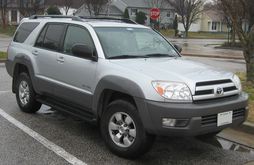


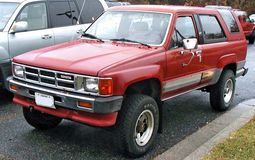
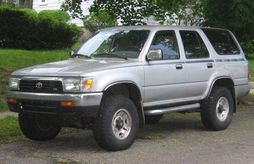
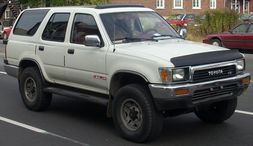


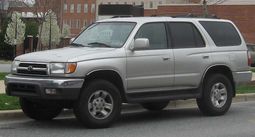
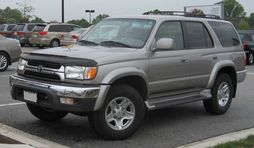
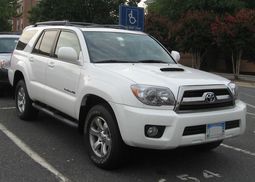
|